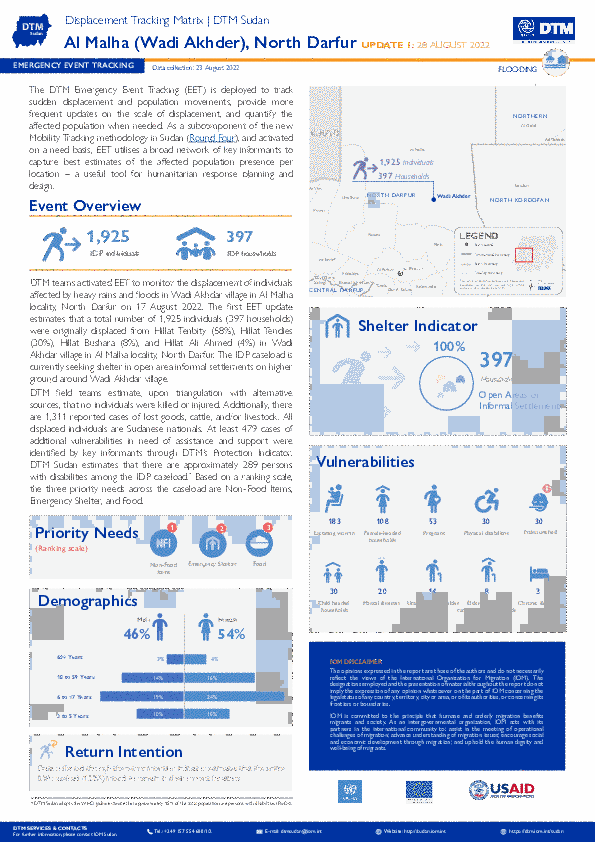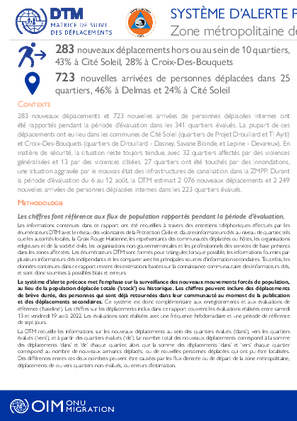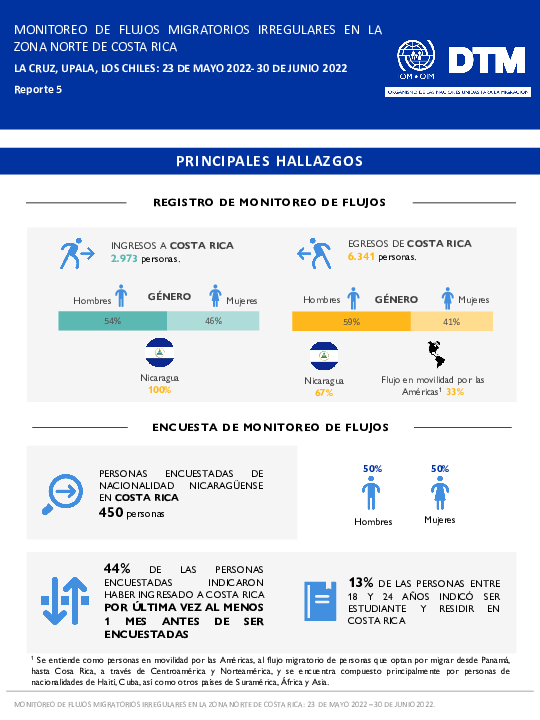-
Countries
-
Data and Analysis
-
Special Focus
-
Crisis Responses

Contact
DTM Sudan; dtmsudan@iom.int
Language
English
Location
Sudan
Snapshot Date
Aug 23 2022
Activity
- Mobility Tracking
- Event Tracking
The DTM Emergency Event Tracking (EET) is deployed to track sudden displacement and population movements, provide more frequent updates on the scale of displacement, and quantify the affected population when needed. As a subcomponent of the new Mobility Tracking methodology in Sudan (Round Four), and activated on a need basis, EET utilises a broad network of key informants to capture best estimates of the affected population presence per location – a useful tool for humanitarian response planning and design.
IOM works with national and local authorities in order to gain a better understanding of population movements throughout Southern Africa. Through the setup of Flow Monitoring Points (FMPs), IOM seeks to quantify migration flows, trends and routes and to gain a better understanding of the profiles of observed individuals at entry, transit or exit points (such as border crossing posts, bus stations, rest areas, police checkpoints and reception centres). This report is an overview of the data collected in these FMPs from 1 to 31 July 2022.
Inter-regional migration from and within the Southern Africa is categorized along the following corridors. The Flow Monitoring Points (FMPs) were set-up in several key transit locations along the corridors to track the movements of passengers:
•Zimbabwe (Mutare) – Mozambique (Manica)
•Zimbabwe – Zambia (Chirundu)
•Zimbabwe – Botswana (Plumtree)
•Zimbabwe (Beitbridge) – South Africa
•Malawi (Mchinji) - Zambia (Mwami)
•Malawi (Karonga ) – United Republic of Tanzania
•Malawi (Mwanza) – Mozambique (Zobue)
•Malawi (Mulanje) – Mozambique
•Mozambique (Ressano Garcia) – South Africa
•Democratic Republic of the Congo (Kasumbalesa) – Zambia
Over the reporting period a total of 79,080 movements were observed across 51 FMPs in the region. The Zimbabwe – South Africa corridor hosted the largest number of movements with 35,308 (45%) followed by the Democratic Republic of Congo (Kasumbalesa) – Zambia corridor with 14,009 (18%) and the (Malawi (Mwanza) – Mozambique (Zobue) corridor with 9,616 movements reported (12%).

Contact
DTMMozambique@iom.int
Language
English
Location
Mozambique
Period Covered
Aug 17 2022
Aug 23 2022
Activity
- Mobility Tracking
- Event Tracking
During the reporting period (17 to 23 August 2022), a total of 58 movements were recorded - 40 arrivals (715 individuals), 9
departures (763 individuals), 7 returns (911 individuals), and 2 transit (486 individuals). The largest arrival movements were
recorded in Macomia (305 individuals) and Meluco (135 individuals). The largest departure movements were recorded in Cidade
de Pemba (615 individuals) and Nangade (130 individuals). The largest return movement was observed in Palma (829 individuals). The only transit movement was observed in Mueda (486 individuals). Of the total population, 5 per cent of mobile groups were displaced for the first time, and 30 per cent for a second time and 65 per cent were displaced prior to the latest movement.

Contact
DTMMozambique@iom.int
Language
English
Location
Mozambique
Period Covered
Aug 10 2022
Aug 16 2022
Activity
- Mobility Tracking
- Event Tracking
During the reporting period (10 to 16 August 2022), a total of 76 movements were recorded - 49 arrivals (12,234 individuals), 15 departures (272 individuals), 11 returns (1,094 individuals), and 1 transit (54 individuals). The largest arrival movements were recorded in Metuge (11,304 individuals), Macomia (271 individuals), and Meluco (202 individuals). The largest departure movements were recorded in Nangade (170 individuals). The largest return movement was observed in Palma (672 individuals) and Quissanga (378 individuals). The only transit movement was observed in Mueda (54 individuals). Of the total population, 3 per cent of mobile groups were displaced for the first time, and 86 per cent for a second time.

Contact
dtmhaiti@iom.int
Language
English
Location
Haiti
Period Covered
Aug 13 2022
Aug 19 2022
Activity
- Event Tracking
283 nouveaux déplacements et 723 nouvelles arrivées de personnes déplacées internes ont été rapportés pendant la période d’évaluation dans les 341 quartiers évalués. La plupart de ces déplacements ont eu lieu dans les communes de Cité Soleil (quartiers de Projet Drouillard et Ti Ayiti) et Croix-Des-Bouquets (quartiers de Drouillard - Dasney, Savane Blonde, et Lepine - Devareux). En matière de sécurité, la situation reste toujors tendue, avec 32 quartiers affectés par des violences généralisées et 13 par des violences ciblées. 27 quartiers ont été touchés par des innondations, une situation aggravée par le mauvais état des infrastructures de canalisation dans la ZMPP. Durant la période d’évaluation du 6 au 12 août, la DTM estimait 2 076 nouveaux déplacements et 2 249 nouvelles arrivées de personnes déplacées internes dans les 223 quartiers évalués.

Contact
Angélica Madrigal amadrigal@iom.int
Language
Spanish
Location
Costa Rica
Period Covered
May 23 2022
Jun 30 2022
Activity
- Survey
- Registration
- Flow Monitoring
Durante el periodo de tiempo que abarca el presente informe, se logró observar un total de 9.314 cruces irregulares en los tres puntos de monitoreo de la frontera entre Costa Rica y Nicaragua. Además, de un total de 554 personas a las que se les solicita participar en la encuesta, 450 de ellas acceden, lo que significa que hubo una tasa de respuesta del 81 porciento. Estas encuestas se aplican a personas migrantes en centros de agrupación y tránsito cotidiano, como terminales de autobuses o paradas de taxis informales. La recolección de información se ha realizado todos los días de la semana, entre 8:00 a.m. y 3:00 p.m. (desde 23 de mayo al 30 de junio de 2022).

Contact
DTMUkraine@iom.int
Language
English
Location
Ukraine
Period Covered
Aug 17 2022
Aug 23 2022
Activity
- Survey
Between 17 and 23 August the International Organization for Migration (IOM) conducted the eighth round of a rapid representative assessment of the general population in Ukraine to gather insights into internal displacement and mobility flows, and to assess local needs. This general population survey serves as a preliminary source to identify areas with high humanitarian needs and to inform the targeting of response aiming to assist the war affected population. The geographical scope of the assessment covers the entire territory of Ukraine, all five macro regions (East, North, Centre, South, and the city of Kyiv), with the exception of the Crimean peninsula. The general population survey was constructed through a random digit dial (RDD) approach, and 2,001 unique and anonymous respondents aged 18 and over were interviewed using the computer assisted telephone interview (CATI) method. The estimates rely on the UNFPA population data for Ukraine, agreed upon as the common population baseline by the humanitarian community. Those currently outside Ukraine were not interviewed. For further notes on method and limitations, including IOM’s definition of internally displaced persons used for the purpose of this assessment, see page 12 In addition to this General Population Survey, data on recorded IDP presence at hromada level in Ukraine are available from IOM’s Displacement Tracking Matrix Baseline Assessment (Round 10, August 26, 2022, HDX, registration required).

Contact
DTM Yemen, iomyemendtm@iom.int
Language
English
Location
Yemen
Period Covered
Aug 21 2022
Aug 27 2022
Activity
- Mobility Tracking
IOM Yemen DTM’s Rapid Displacement Tracking (RDT) tool collects data on estimated numbers of households forced to flee on a daily basis from their locations of origin or displacement, allowing for regular reporting of new displacements in terms of estimated numbers, geography, and needs. It also tracks returnees who returned to their location of origin.
From 1 January to 27 August 2022, IOM Yemen DTM tracked 8,496 households (HH) (50,976 Individuals) who experienced displacement at least once.
Between 21 and 27 August 2022, IOM Yemen DTM tracked 63 households (378 individuals) displaced at least once. The majority of people moved into/within the following governorates and districts:
- Marib (25 HHs) – Marib City (21 HHs), Marib (4 HHs) districts. Most displacements in the governorate originated from Shabwah and Sanaa City.
- Shabwah (16 HHs) – Ayn (16 HHs) district. All displacements in the governorate originated from Marib.
- Taiz (9 HHs) – Al Qahirah (6 HHs), Al Mudhaffar (2 HHs), Salah (1 HH) districts. All displacements in the governorate were internal.
The majority of people moved from the following governorates and districts:
- Taiz (17 HHs) – Maqbanah (10 HHs), Jabal Habashi (4 HHs), At Taiziyah (2 HHs) districts.
- Marib (17 HHs) – Harib (16 HHs), Al Jubah (1 HH) districts.
- Shabwah (16 HHs) – Ataq (14 HHs), Osaylan (2 HHs) districts.
Contact
DTM Yemen, iomyemendtm@iom.int
Location
Yemen
Activity
- Mobility Tracking
- Event Tracking
Period Covered
Aug 21 2022 -Aug 27 2022
From 1 January to 27 August 2022, IOM Yemen DTM tracked 8,496 households (HH) (50,976 Individuals) who experienced displacement at least once.
Between 21 and 27 August 2022, IOM Yemen DTM tracked 63 households (378 individuals) displaced at least once. The majority of people moved into/within the following governorates and districts:
- Marib (25 HHs) – Marib City (21 HHs), Marib (4 HHs) districts. Most displacements in the governorate originated from Shabwah and Sanaa City.
- Shabwah (16 HHs) – Ayn (16 HHs) district. All displacements in the governorate originated from Marib.
- Taiz (9 HHs) – Al Qahirah (6 HHs), Al Mudhaffar (2 HHs), Salah (1 HHs) districts. All displacements in the governorate were internal.
- Taiz (17 HHs) – Maqbanah (10 HHs), Jabal Habashi (4 HHs), At Taiziyah (2 HHs) districts.
- Marib (17 HHs) – Harib (16 HHs), Al Jubah (1 HH) districts.
- Shabwah (16 HHs) – Ataq (14 HHs), Osaylan (2 HHs) districts.
Population Groups
Survey Methodology
Unit of Analysis Or Observation
Type of Survey or Assessment
Keywords
Geographical Scope
Administrative boundaries with available data
The current dataset covers the following administrative boundaries

Contact
DTM Pakistan, iomisbdtmremapteam@iom.int
Language
English
Location
Pakistan
Period Covered
Jul 02 2022
Jul 15 2022
Activity
- Flow Monitoring
IOM Pakistan collects data on the outflows of undocumented Afghan migrants at the Torkham and Chaman border crossing points in an effort to better understand the migration movements of undocumented Afghan migrants returning to Afghanistan from Pakistan. This exercise is part of the European Union funded project “Displacement Tracking Matrix Regional Evidence for Migration Analysis and Policy (DTM REMAP)”. From 02 to 15 July 2022, 1,478 undocumented Afghan migrants returned to Afghanistan from Pakistan, including 588 through the Torkham border point and 890 through the Chaman border point. During the reporting period, border authorities facilitated the return of 36 individuals due to the lack of legal documentation to remain in Pakistan. Therefore, information concerning these 36 individuals is not included in the report analysis.

